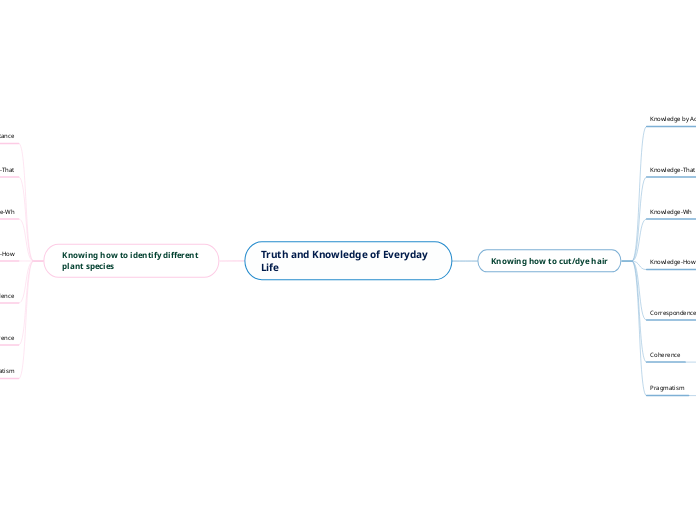Truth and Knowledge of Everyday Life
Knowing how to cut/dye hair
Knowledge by Acquaintance
learning how to cut hair by helping
out in a salon and being taught
by a professional
Knowledge-That
a person can state or claim they can cut hair
but that doesn't make them a hairstylist- simply
stating you know how to cut hair is very different from
actually being able to.
Knowledge-Wh
how a person interacts and uses hair cutting tools
and supply's, determines WHether they can cut hair well
or not
Knowledge-How
when cutting or dying hair a person
requires certain skills. Such as, knowing product ratios,
organization, knowing how to properly use scissors to layer hair etc.
Correspondence
the falsity or truth of this statement depends
their abilities when doing hair.
the statement is false if the persons actions and
abilities does not correspond with their statement; if they cannot cut hair well, their statements do not correspond and they are false
the statement is true if the persons abilites does
correspond with their statement; if they show they can cut hair well, their statements do correspond and it is true.
Coherence
states that for something to be true, it needs to be
coherent with other statements
If someone believes they need to have skills with
scissors or hair dye, and believe they have the necessary skills, their ideals cohere, making the statement true.
Pragmatism
Highlights the importance of how much value a
statement has
Knowing how to do hair is valubale and comes with many perks
Knowing how to identify different
plant species
Knowledge by Aqcuaintance
Learning and attaining the knowledge of how to
distinquish different plant speices from experience; eg. gardening
Knowledge-That
Claiming to be able recognize and distinguish different plant speices
Knowledge-Wh
The propositional knowledge within the statement
would be "whether" the person can identify different plant speices.
Knowledge-How
Being able to identify different plants within a natural
setting to others is evidence a person knows how to identify different plant species
Correspondence
The falsity or truth of this statement relates to how
the person would interact and identify the plant.
Incorrectly idenifying a plant; saying a tulip is a rose, which doesn't accuratley describe them, thus making the statement false.
Correctly and properly being able to identify a plant aligns this statement to reality, making the statement true.
Coherence
In order for something to be true, it needs to be coherent with the other statements.
If someone is determining whether a flower is a rose or sunflower by taking note of the size, petals and colour, they need to ensure they know the characteristic of those flowers.
Pragmatism
Why a statement is important or holds enough value to be considered pragmatic, thus making it a true statement.
